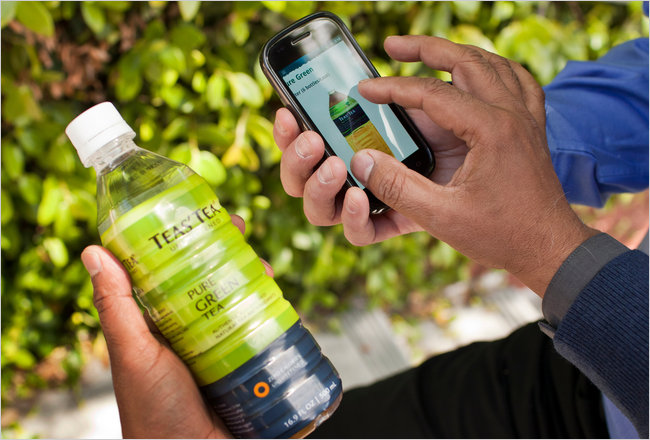NY Times: Google, mobile search giant, looking for new revenue opportunities

Google, already the undisputed leader of mobile search, does not rest on its laurels. The search giant casts its resources on solving specific problems related to mobile devices.
In early 2008, at the dawn of the era of the Phone, Google engineers began to notice something unusual in the search engine logs. Owners of new phones generated a significant amount of traffic.
But there was a problem: the search on the phone was far from ideal. It's hard to type on a small screen. And the most annoying for Google, boasting the speed of its search, was that the webpage on the phone was loading very slowly.
')
In this regard, Google launched a project codenamed Grand Prix. In six weeks, Google engineers updated their mobile search and created a new search strategy in which requests are made by voice or using photos instead of typing from a mobile keyboard.
The stakes were high. Mobile phones could become both a new market for Google and open up the possibility for competitors to destroy the search engine market. If people can access information through special applications, why do we need Google.
Scott Huffman on the left and Amit Singhal, Google. Google Voice Search has taught people to communicate with requests
 Today, according to Google, mobile search is growing as fast as a web search in the early years of the company’s existence, and a six-fold increase has been made in the past two years. According to statistics StatCounter, which tracks the dynamics of the development of the web, Google has a share of 97% of mobile search.
Today, according to Google, mobile search is growing as fast as a web search in the early years of the company’s existence, and a six-fold increase has been made in the past two years. According to statistics StatCounter, which tracks the dynamics of the development of the web, Google has a share of 97% of mobile search.Now that the market dominance issue has been resolved, Google throws all of its computing power and data it receives into solving mobile phone-specific problems — how to translate phone conversations from language to language or how to recognize flowers or clothing brands.
“I feel like having a second child,” says Amit Singhal, a Google search employee. “Our firstborn grew up so fast, and now our second child, mobile, is growing at the same pace and showing the same results.”
Google is not in a hurry to learn new competencies in Internet business, especially with regard to social networks . Investors criticize the company for dragging its feet when it comes to making money in the new realities of the Internet environment.
But the mobile market is an exception. Last year, Eric Schmidt, the company's chief executive officer, identified Google’s philosophy as “mobile forward,” meaning the development of mobile applications and computer programs.
“This is the map on which Google, in effect, puts its future," says Karim Temsamani, head of mobile advertising for Google; a position opened in September.
However, Google didn’t carefully follow its mobile mantra, and some analysts, including Colin W. Gillis from BGC Partners, commented on Google’s slowness in creating mobile products or advertising.
“They did a very good job of positioning themselves in this market and now you can't just forget everything,” says Mr. Gillis. “Now they just have to create innovative products and squeeze everything possible out of this situation.”
In October, Google announced that next-year mobile ad revenue could be close to $ 1 billion. Mobile phone users will be able to call organizations using Google advertisements, or receive discount coupons at nearby stores. Having photographed a movie poster by phone , you can immediately download the trailer. As Temsamani notes, with the advent of new technologies for tracking users' locations, advertisers have been able to increase customer loyalty with gifts that encourage shopping.
But since mobile ads are usually sold for less than half the price of online advertising, “such ads are not profitable enough,” Mr. Gillis. Despite the fact that Google creates software for Android phones, it does not make money on it directly, because it gives its part to the phone manufacturers. Meanwhile, Apple makes money both on its own device, and on the fact that it is present on the screens of its own advertising network.
Nevertheless, the company's approach to the mobile market is quite classic for Google: to take a number of problems that developers have been fighting for many years, to throw computational power and huge amounts of data on them and to assume that if the final product will be useful for people That means it will inevitably be profitable.
Today, people can take pictures of sights or wine labels to search using Google Goggles , talk to the phone using voice search , and translate live dialogue from English to Spanish on Android phones, and vice versa.
“We, as a community of scientists, are capable of solving such problems, but we could not implement a system of this magnitude,” said Alexei A. Efros, a professor of computer science and robotics at Carnegie Mellon, bearing in mind Google’s technological advances. “Indeed, Google’s great merit is that it can make everything so large-scale and useful to many.”
Taking the recorded speech fragments as a basis, Google trained its computers to understand conversational speech. “Even if you’re from Brooklyn and you’re missing everything,” the system has heard a lot of people from Brooklyn and will understand you, ”said Mike Cohen, head of the Google speech technology team.
At first, Google engineers thought that people would communicate with the recognition system as if they were communicating with a person: “You know ... this is my anniversary, and I would like to invite my wife somewhere ... to a very romantic place to eat ... What can you suggest? ”That's how they trained the system to filter out unnecessary words later. But it turned out that Google got people who are already thinking by search queries, who understand that even for voice search you need to say “romantic restaurant”.
Goggles, a visual search tool, recognizes things that have certain visual boundaries, such as a barcode, book cover, or building. But with the help of this application it is often impossible to determine, for example, the differences between a black cat and a black chair or to recognize a food or a plant, although Google cooperates with nerds to train their cars on the nuances of foliage structure. Google already has the ability to recognize faces, so that people can take a picture of someone on the street and immediately find that person’s online account, but this technology is not used, as there are still legal restrictions on privacy.
People can take a photo of the menu in a foreign language and translate it immediately, or speak English, receiving a Spanish translation. As Franz Och, the head of the Google machine translation group , says, one day it will be possible to translate a speech that sounds freely on both ends of the phone.
Despite the fact that the results of issuing Google on the phone and on the computer may seem the same, there are a number of differences that are not visible at first glance.
For example, some search results are ranked differently, depending on location. When you request Wal-Mart from a Google computer, you are most likely looking for an e-commerce site or job offer. When searching from a Google phone, it assumes that you are looking for the nearest store. Other search tools were created specifically for phones. Searching for weather or stock prices is arranged so that when searching with your fingers you can see results for different time periods.
Google says that mobile search does not take away the total time of computer searches. Instead, the peak of the mobile search is the time of the lunch break and the evening when people are away from their computer. And despite the fact that many mobile users are looking for simple things like the weather or train schedules, there are those who surprise Google developers by asking difficult questions about business or politics.
“Mobile search will certainly exceed the search from desktop computers,” said Scott B. Huffman, who is working on mobile search and leading the development team in this area. “The frontier will be passed, and I think it will be completed before anyone sees it.”
Source: https://habr.com/ru/post/118285/
All Articles